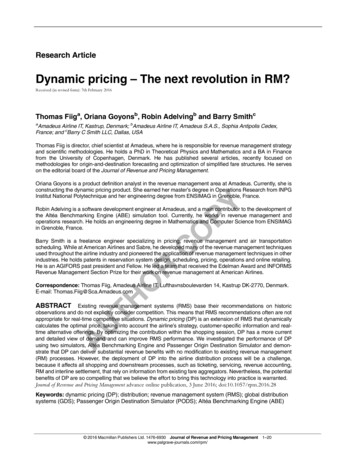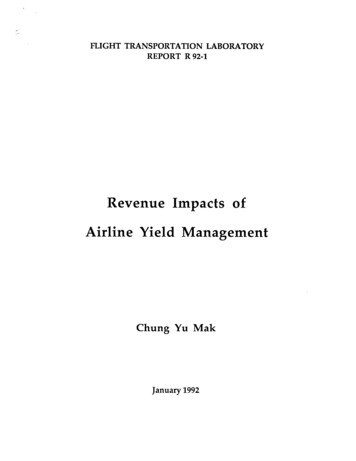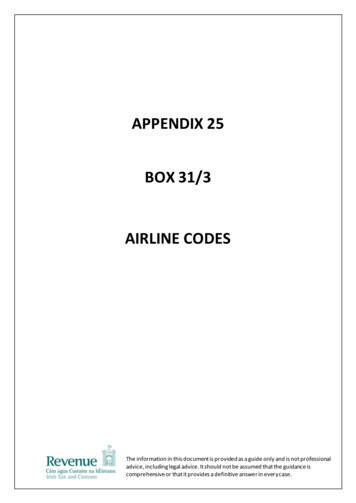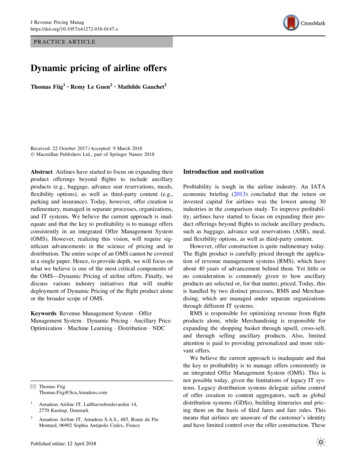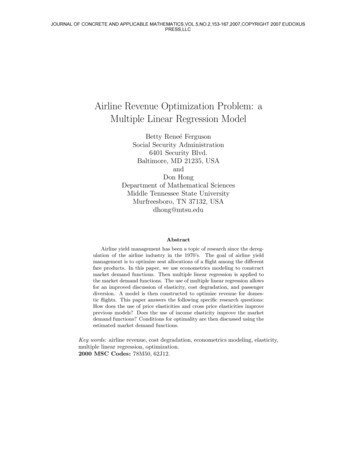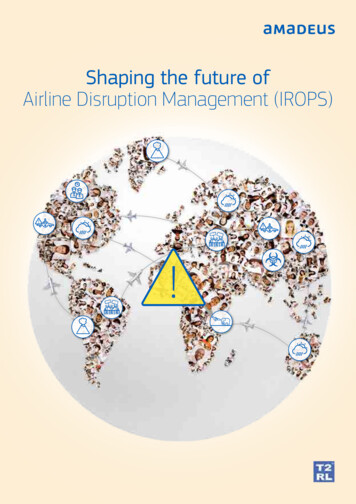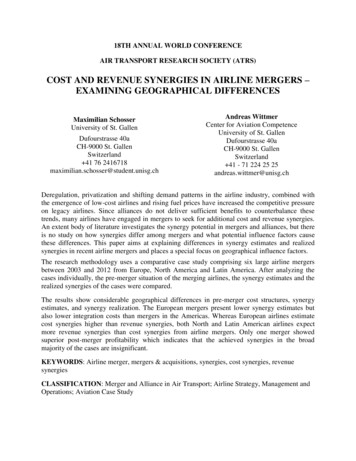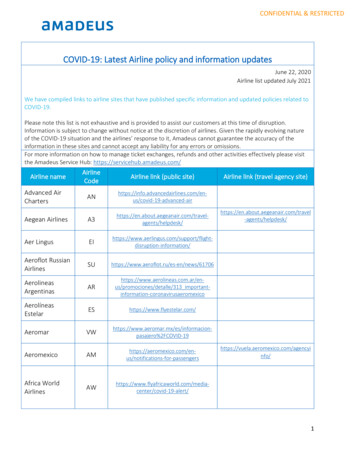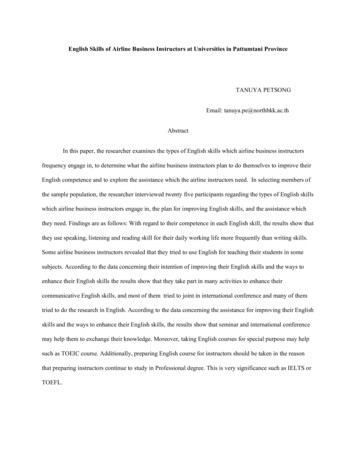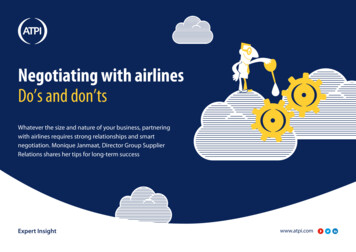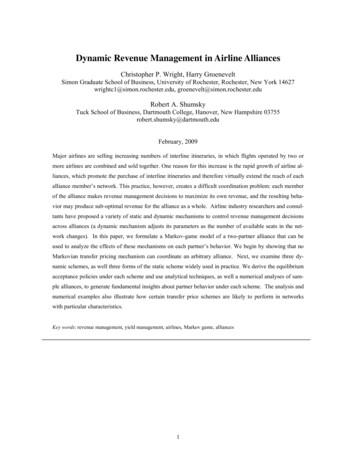
Transcription
Dynamic Revenue Management in Airline AlliancesChristopher P. Wright, Harry GroeneveltSimon Graduate School of Business, University of Rochester, Rochester, New York 14627wrightc1@simon.rochester.edu, groenevelt@simon.rochester.eduRobert A. ShumskyTuck School of Business, Dartmouth College, Hanover, New Hampshire 03755robert.shumsky@dartmouth.eduFebruary, 2009Major airlines are selling increasing numbers of interline itineraries, in which flights operated by two ormore airlines are combined and sold together. One reason for this increase is the rapid growth of airline alliances, which promote the purchase of interline itineraries and therefore virtually extend the reach of eachalliance member’s network. This practice, however, creates a difficult coordination problem: each memberof the alliance makes revenue management decisions to maximize its own revenue, and the resulting behavior may produce sub-optimal revenue for the alliance as a whole. Airline industry researchers and consultants have proposed a variety of static and dynamic mechanisms to control revenue management decisionsacross alliances (a dynamic mechanism adjusts its parameters as the number of available seats in the network changes). In this paper, we formulate a Markov-game model of a two-partner alliance that can beused to analyze the effects of these mechanisms on each partner’s behavior. We begin by showing that noMarkovian transfer pricing mechanism can coordinate an arbitrary alliance. Next, we examine three dynamic schemes, as well three forms of the static scheme widely used in practice. We derive the equilibriumacceptance policies under each scheme and use analytical techniques, as well a numerical analyses of sample alliances, to generate fundamental insights about partner behavior under each scheme. The analysis andnumerical examples also illustrate how certain transfer price schemes are likely to perform in networkswith particular characteristics.Key words: revenue management, yield management, airlines, Markov game, alliances1
1.IntroductionWhen one of the authors recently planned a trip from Boston to Barcelona, British Airwaysoffered a convenient itinerary for 823. The itinerary began with a leg on British Airways fromBoston to London, followed by a second leg on another airline, Iberia, to Barcelona. We willcall such an itinerary an interline itinerary, for it includes service on multiple airlines. Theavailability of this two-leg interline itinerary for this fare is contingent on two decisions: (1) theairline who sells the ticket (the marketing airline, in this example British airways) must make aseat available on one leg, and (2) the operator of the other leg (the operating airline, Iberia) mustagree to accept the connecting passenger from the marketing airline. Because both airlines practice revenue management, these decisions depend upon the price paid by the consumer to themarketing airline for the ticket and the price paid by the marketing airline to the operating airlinefor the use of a seat. This article examines agreements among airlines that govern the latterprice, sometimes called revenue sharing, transfer price, or proration agreements. We show howthese agreements have subtle and potentially significant effects on individual airline behavior aswell as on the total revenue collected by multiple airlines across their combined networks.It is becoming increasingly important to understand the impact of proration agreements onairline revenue management because sales of interline itineraries have been growing. This increase is due in part to a type of marketing arrangement called a code-share agreement. Underthis arrangement, the operating airline’s flight is also listed as a flight with the marketing airline’s name. In the example above, the second leg had an Iberia flight number, but was also labeled British Airways Flight 7073 from London to Barcelona. Analysis of data from the U.S.Department of Transportation (BTS, 2006) reveals that the fraction of interline itineraries withinthe U.S. rose from 10% in 1998 to 20% in 2004, and most of those interline itineraries weremarketed under code-share agreements. Overall, 46% of revenues collected from U.S. domesticflights in 2004 came from interline itineraries.A second factor driving up interline traffic is the growth of airline alliances. These alliancesusually combine code-share agreements with other arrangements, such as schedule coordinationand the merger of frequent-flier programs. In March 2006, 59% of all worldwide ASMs (available seat miles, a measure of total capacity equal to the number of seats multiplied by the number2
of miles flown, summed over all flights) were flown by airlines belonging to one of the threelargest international alliances, Star, SkyTeam or Oneworld (Lott, 2006). Both international andU.S. alliance activity are expected to grow (Lott, 2006; Belden, 2007; Shumsky, 2006).While these international alliances facilitate formal marketing and operational arrangementsamong airlines, this paper uses the term alliance in a much weaker sense: an alliance is formedby any two airlines that exchange interline passengers and that have a proration agreement forthe revenue collected from the sale of interline itineraries.In practice, the rules for revenue sharing are usually laid out in special prorate agreements(SPAs) that are negotiated by alliance partners. In the absence of an SPA, airlines follow therules set out by the International Air Transport Association (see IATA, 2007, for details of therules to be implemented over the next few years). Whether they are encoded in an SPA or by theIATA, most rules include fixed transfer prices for particular flight/fare-class combinations, orother simple allocation procedures such as a split in revenue (a proration rate) based on relativemileage. For example, under such a mileage proration scheme, British Airways would receivethe lion’s share of the 823 in the example above for its Boston-to-London flight. Throughoutthis paper we call such rules static schemes, for they do not adjust proration rates as demand isrealized and seats are sold.Although static schemes are easy to manage, they can lead to suboptimal decision-making bymember airlines and lost revenue for the alliance as a whole. For our example, under mileageproration Iberia would receive a relatively small share of the ticket revenue when flying interlinepassengers. Therefore, Iberia may choose to focus on its own (non-interline) customers and nothold seats for British Airways customers, who may be more lucrative for the alliance. The underlying flaw in any static proration scheme is that the revenue-sharing proportions are not adjusted to reflect the actual value of seat inventory. Because the revenue management system ofeach airline in the alliance maximizes the revenue of that airline, an airline may reject an itinerary if the transfer price undervalues the real-time value of its seats, even if the total revenuefrom the itinerary is large.Given the deficiencies of static schemes, major airlines are considering dynamic schemes,such as the use of the real-time opportunity costs of seats, or “bid prices,” as transfer prices. Inthis paper we examine dynamic schemes that have been described in the published literature (see3
Vinod, 2005) and have been suggested to the authors by industry executives and revenue managers. In the industry there is interest in dynamic schemes, but also much uncertainty. There arecertainly technical and legal barriers to implementation; for example, antitrust legislation in theU.S. prohibits the exchange of certain types of information among airlines. But another significant barrier is uncertainty over how revenue-maximizing airlines would respond to dynamicschemes, and whether such schemes would produce real benefits to the alliance. In fact, there isno published literature on this topic and, to our knowledge; there has been no rigorous analysisof these effects by researchers within the industry. This paper is a first attempt to fill that gap.Now we summarize the organization of the paper and its results. After reviewing the relevant literature in §2, in §3 we describe our general model for a two-airline alliance. In §4 wedescribe a centralized network and determine the first-best policies for a centralized yield management system. In §5 we describe a two-airline alliance model and analyze static and dynamictransfer price schemes. In this section we first use a counterexample to show that no dynamicscheme is guaranteed to maximize alliance-wide revenue, unless the dynamic scheme includesrevenue-sharing rules that depend upon the sample path of inventory sales (note that a schemebased on sample paths would be orders of magnitude more complex than the static and dynamicschemes being considered by the airlines). We then derive equilibrium policies for the alliancepartners under certain dynamic schemes, and we use the analysis to highlight the strengths andweaknesses of the schemes in terms of total alliance revenue. In §6 we describe numerical experiments that support the insights from §5. The experiments also compare the performance ofstatic and dynamic schemes, given certain network parameters. We find that static schemes canperform as well as dynamic schemes for certain networks, but that the performance of a staticscheme that is optimal for one network can degrade quickly as the network parameters change.Dynamic schemes often perform better and are more robust. We find, however, that the performance of dynamic schemes can be significantly reduced if each operating airline chooses a transfer price to maximize its own revenue. Such would be the case, for example, if the partners initially agree to use bid prices as transfer prices, but then each partner attempts to increase its revenue by reporting incorrect bid prices. Finally, in §7 we summarize our results and describe future research.4
There are a few caveats for the results in this paper. First, we make strong assumptions aboutthe amount of information available to each alliance partner. Specifically, we use a Markovgame model to describe the alliance, and we use the Nash equilibrium to describe the airlines’behavior under each proration scheme. For legal and technical reasons the airlines cannot coordinate their revenue management systems, so it is appropriate to use the tools of noncooperativegame theory. To keep the problem tractable, however, we assume that the airlines share thesame information about the state of the game and the distribution of future events, e.g., each airline has perfect information about its partner’s inventory level, and both have identical forecastsof future arrival probabilities and revenue distributions over the entire alliance network (in technical terms, we define a game of complete information). While this assumption is not realistic,we believe that the amount of transparency in the industry is increasing. For example, airlinesregularly use the web to monitor the lowest available fare of their competitors, and hire “marketintelligence services” such as QL2 (www.ql2.com) to gather information about competitor actions. Our model represents a logical extreme case, and the full-information assumption allowsus to generate fundamental insights on how certain proration schemes behave. We provide additional details and discussion of our information-sharing assumptions in §3.2. In general, analysisof games with incomplete information will be an interesting area for further research.A second caveat is that that the numerical experiments described in §6 were conducted usingsmall networks, in terms of the number of flights and the number of seats. Again, our purpose isto gain basic insights, i.e., to identify the fundamental advantages and disadvantages of eachtransfer price scheme. In addition, we demonstrate that many of these insights apply as the number of seats in the network grows. An important area for additional research, however, will be toexamine alliance performance over networks of realistic size.Finally, at a higher level than our analysis, the alliance partners are engaged in a cooperativeprocess to determine which routes should be available for interline traffic and what prorationrules to use on those routes. In general, the partners seek to increases alliance-wide revenue andto allocate revenues so that all members are willing to participate in the alliance. We do notmodel this higher-level process. Instead, our model provides information about how airlines behave, and how total revenues are affected, given sets of interline routes and particular prorationrules. Models that focus on the higher-level problem have begun to appear in the literature, e.g.,5
Agarwal and Ergun (2007) examine the allocation mechanism design problem for cargo shippers. For airline revenue management, successful high-level negotiations depend upon information about the effects of particular proration schemes on network revenues. To our knowledge,the model presented here is the first to provide such information.2.Literature ReviewRevenue management (also referred to as yield management) and its application to the airlineindustry have received a great deal of attention since the 1970s when Littlewood (1972) first described the basic problem. In that article, Littlewood introduces the result (now referred to asLittlewood’s rule) that a request for a seat should be fulfilled only if its revenue exceeds the expected future value of the seat in question. This intuitive rule forms the basis of many controlpolicies in both theory and practice.Numerous authors have expanded on Littlewood’s work. See, for example, Belobaba (1989)who examines a problem with multiple fare-restriction combinations, Glover et al. (1982) wholooks at the passenger mix problem in a network environment, You (1999) who examines a dynamic pricing model, and Talluri and van Ryzin (2004a) who utilize a discrete choice model ofdemand. For a more thorough description of the revenue management literature, see the surveyby McGill and van Ryzin (1999) and the book by Talluri and van Ryzin (2004b).The use of competitive game theory in revenue management has been limited. Vulcano et al.(2002) examine a dynamic game in which a seller faces a sequence of customers who competewith each other in an auction for a fixed number of units. Netessine and Shumsky (2004) examine both horizontal and vertical competition between two airlines, where each airline flies asingle leg.Several aspects of airline alliances have been examined in the literature. Barron (1997) discusses many of the legal implications of airline alliances, focusing on code-sharing agreementsused widely in the industry. Park (1997) and Brueckner (2001) examine the economic effects ofalliances on fares, traffic levels, profits and market welfare. Brueckner and Whalen (2000) provide an empirical analysis of the effects of international alliances on fares, showing that interlinefares charged by alliances are approximately 25% lower than those charged by non-allied carriers. Ito and Lee (2006) examine the impact of domestic alliances on airfares.6
Little attention, however, has been given to how revenue management should be implemented by an airline alliance. Wynn (1995) describes simple transfer price schemes based on thevalue of local fares. Boyd (1998a) discusses the methodological and technical challenges of thealliance revenue management problem. He also refers to a more formal analysis in an unpublished working paper (Boyd, 1998b) in which he formulates a static linear program to describethe alliance revenue management problem. Boyd then derives conditions under which the seatallocation between the two airlines maximizes alliance-wide revenue under this model. Vinod(2005) describes many of the alliance coordination mechanisms now being considered by theairlines, but provides no formal analysis of their advantages and disadvantages. Some of theschemes analyzed in this paper correspond to mechanisms described by Vinod. Shumsky (2006)argues that low-cost competitors are driving the network airlines to rely on alliances for an increasing proportion of their traffic. Both Shumsky (2006) and Fernandez de la Torre (1999) discuss the need for more research on the effectiveness of alliance agreements, a need we attempt tofill here. In their paper on revenue management games, Netessine and Shumsky (2004) describeand analyze a static alliance revenue-sharing mechanism for a two-leg network based on the expected flow of passengers. In this paper we analyze the performance of dynamic coordinationmechanisms that are designed for arbitrary alliance networks and are similar to schemes that areproposed by, or actually used by, the airlines.Ongoing research by Houghtalin et al. (2007) and Agarwal and Ergun (2007) looks at variousaspects of alliances, focusing specifically on cargo carriers. In addition to the inherent differencebetween the cargo and passenger revenue management problems (see Kasilingam 1996), theiranalysis differs from ours in two fundamental ways: 1) they focus on the high-level alliance formation problem, with cooperative game theory as the appropriate method, while we formulate anoncooperative game, given an existing alliance and particular revenue-sharing rules; and 2) theyfocus on a deterministic optimization problem in which all demand for cargo service has beenrealized before routing decisions are made, while our passenger yield management problem ismost appropriately described by a model in which demand is uncertain and arrives over time.Finally, this paper is related to the extensive literature on supply chain coordination. SeeNagarajan and Sošić (2008) and Cachon and Netessine (2004) for overviews of the related literature that use, respectively, cooperative and competitive game theory. There are several attributes7
of our problem, however, that distinguish it from this research stream. First, the flow of productsin the traditional supply chain literature moves in one direction, from raw materials to the consumer. Therefore the unused product does not move ’sideways’ within a level. Second, in thesupply chain literature, production of a product begins at one level with one set of firms (suppliers) and demand is fulfilled at another level by another set of firms (retailers). Neither attributeholds for our problem. For a specific contrast, consider the literature on assembly systems, forwe can think of a multi-leg itinerary as a final product assembled from multiple components. Inthe traditional supply chain literature, an assembler receives components from several suppliersthat are combined to create a new product to sell (e.g, Nagarajan and Bassok, 2008 and Granotand Yin, 2008.) In our model either airline may serve as the marketing airline, the de facto assembler, and either airline may serve as the operating airline, the de facto supplier.In addition, the traditional research on supply chain coordination focuses on either singleperiod newsvendor problems (e.g., Lariviere and Porteus, 2001) or repeated games in which inventory is replenished between each repetition of the game (e.g., Cachon and Zipkin, 1999). Thecharacteristics of such problems are quite different from ours, a finite, multi-period problem withfixed capacity allocated to a stochastic arrival stream. Certain results from our paper may besimilar in interpretation to results from the research on the economics of supply chains. For example, the effect of the partner price scheme in §5.4.3 can be seen as a form of doublemarginalization (Spengler, 1950). In general, however, our problem context, model and key results are quite different from those in the supply chain literature.3.General Alliance Network ModelWe consider a dynamic model of an alliance consisting of two partner airlines (carriers), in-dexed by c {1, 2} (in a slight abuse of notation, we will denote the “other” airline by -c insteadof by 3 – c). The model can be seen as an extension of the network model described by Talluriand van Ryzin (1998) into a two-player game framework.Each flight leg in the network is characterized by an origin, destination, and departure time(for the remainder of this paper the terms ‘flight’ and ‘flight leg’ are used interchangeably). Thenumber of flights operated by airline c is denoted mc and m m1 m 2 is the total number offlights offered by the alliance. The alliance offers n itineraries, and each itinerary is either a sin-8
gle flight or a series of connecting flights within one or both networks. The set of all itineraries isdenoted N and has cardinality n. Within the alliance, these itineraries are divided into three subsets: those that involve only airline 1’s flights (N1), those that involve only airline 2’s flights (N2)and those that use flights from both airlines (NS). Let n1 , n 2 and n S be the cardinality of eachsubset, so that n n1 n 2 n S . We will refer to the sets N1 and N2 as intraline itineraries and theset NS as interline itineraries because at least one leg on any itinerary in NS will not be operatedby the airline that sold the ticket.We use the matrix A to specify the inventory requirements of the itineraries offered by the alliance. The matrix element Aijis the number of seats on flight i required for itinerary j, andtherefore the column vector A j specifies the total inventory required from the alliance networkto satisfy itinerary j. In discussions below, we will assume that each request is for an individualpassenger (i.e., Aij {0,1} ), however group (multi-seat) requests could be handled by creatingadditional columns with each positive element equaling the number of passengers in the group.For example, an itinerary from Rochester, NY to Denver, CO that passes through Chicago, ILwould have 1’s in the rows for Rochester-Chicago and from Chicago-Denver. To handle a family of 4 looking to make the same trip, A would need another column with 4’s in those same rows.For clarity, A can be partitioned as follows,11A N1N2NSA10AS10A2AS2 n1 n1 1 n1 n2 n1 n2 1 nm1m1 1msuch that the first n1 columns have only positive elements in the first m1 rows (airline 1’s network), the next n 2 columns have only positive elements in the last m 2 rows (airline 2’s network)and the final n S columns have positive elements in both sets of rows.While interline itineraries may be sold by either alliance partner (requests for itineraries in NSmay be received by either airline 1 or 2), we assume that intraline itineraries are only sold by theairline that operates the flights (requests for itineraries in Nc are only received by airline c). Inpractice, airlines do sell tickets for itineraries that are exclusively on another airline’s network.With some additional notation, this possibility can be incorporated into the model, and all of the9
following results will continue to hold. To keep the exposition and notation simple we will assume that each airline handles its own intraline requests.The number of remaining (unsold) seats for flight i is denoted x i . The m-dimensional vectorx is the joint vector of remaining inventory for the alliance: x {x1 , , x m , x m 1 x m }.113.1. The Demand ProcessWe consider a K-period booking horizon, with the current period, denoted k, decreasing fromK to 0. The probability that airline c receives a request for itinerary j in period k is qkcj 0 . Weassume that each period is short enough such that the probability that the alliance receives morethan one itinerary request in a given period is negligible. The probability that no request arrivesis then:qk0 1 qc {1,2} j Ncjk 0.(1)The revenue Rkcj associated with a request to airline c for itinerary j in a given period k,conditional on a request being made, is a nonnegative random variable with known cumulativedistribution function (CDF) Fkcj (r ) . We assume that Rkcj has a finite expectation. The complementary CDF is Fkcj (r ) 1 Fkcj (r ) . Note that ‘c’ in Rkcj is the carrier that receives the consumer’s request (the marketing airline). We assume that Fkcj (r ) is differentiable with known densityfunction f kcj (r ) . However, wherever we express our results in terms of f kcj (r ) , similar resultscan be found for non-continuous distributions.3.2. Assumptions about the Arrival Process and Information-SharingWe assume that the distribution of each Rkcj is independent of the realized revenue in preceding periods. Even simple (first-order) dependency, while theoretically easy to handle with ourmodel, would be notationally and computationally cumbersome.In addition, assume that each player formulates an open-loop dynamic program that does notutilize the realized arrival/revenue stream as feedback for its optimization problem. One couldimagine several closed-loop variations of our model. For example, demand intensity for a givenitinerary could be characterized by an unknown parameter, which would be updated as demandis realized. Such models would be quite complex and in practice would likely be handled by up-10
dating the inputs to the model over the horizon without explicitly accounting for the future effects of this updating process when calculating the current value functions.We also assume that there is independence between acceptance decisions in one period andthe arrival process in subsequent periods. Specifically, we assume that a customer, when denieda ticket, will not submit a new request to the alliance for the same or a similar itinerary. This assumption is consistent with the assumptions that underlie many of the models in the revenuemanagement literature. Incorporating multiple customer preferences into the optimization problem is an area of ongoing research (e.g., see Talluri and van Ryzin, 2004a). Within alliances,this behavior would add an interesting wrinkle to our problem because the revenue managementdecisions of each airline could, potentially, affect the arrival process of its partners.As noted in §1, in our model the airlines share full information about their partner’s inventory levels, forecasts of arrival processes, and revenue distributions. This allows the airlines tocalculate, in each time period, a common expected value for a seat on any flight in the network.Using the terminology of game theory, we assume that each airline knows the strategies andpayoffs of its partner and therefore plays a game of complete information. While this model isstylized, it allows us to generate fundamental insights into the advantages and disadvantages ofstatic and dynamic transfer price schemes.While we assume that each airline knows the potential payoffs of its partners, we do not assume that each airline immediately observes realized payoffs. Specifically, under the partnerprice scheme of §5.4.3, the operating airline must post its transfer prices for interline inventorywithout knowing the realized revenue associated with an interline request in that period (ofcourse, the marketing airline sees any realized revenue). Therefore, the partners are playing agame of imperfect information. This assumption reflects an important source of informationasymmetry found in the real world. For a given itinerary there exist numerous classes and distribution channels through which the ticket can be sold; the range of prices across these classesand channels creates the distribution Fkcj (r ) of revenue for each itinerary. Although the operatingairline may know the distribution of revenue because prices are publicly posted, it cannot knowthe specific class being sold or channel being used at the moment the marketing airline receives aspecific purchase request.11
3.3. Assumptions about Revenue SharingIn general, the proration scheme used by the alliance will influence both the total revenue received by the alliance and the allocation of revenues to each of the partners. We assume that theultimate goal of each partner is to maximize its own wealth (revenue). It is reasonable to assume, however, that by forming an alliance, the partners are seeking a scheme that increases theirjoint profits, using some form of ex-ante revenue distribution (e.g., a participation fee) to ensurethat all members of the alliance will continue to participate. In practice, this problem is oftensolved by finding a set of interline routes on each airline that leads to a rough balance in the revenue exchanged between the airlines (Ito and Lee, 2006). The choice of mechanism for the distribution of total revenues is a bargaining problem that we do not examine here. We assume thatsome mechanism has already been chosen and that both airlines are willing to participate in thealliance. Therefore, our primary focus will be on examining how the various trading schemesaffect total alliance revenue.4.Centralized ControlHere we describe the optimal policy for a single, centralized controller making all decisionsto maximize total alliance revenue. In general, members of an airline alliance cannot adopt centralized revenue management controls (see the end of this section for further discussion), butthese results are useful as they lead to an upper-bound on the total revenue for the alliance. Wewill call this upper bound the first-best revenue.4.1. Decision ProcessThe fundamental decision made by the centralized controller is whether to accept or reject acjrequest for an itinerary j, given the revenue offer Rk and the current state of the system: the remaining periods, k, and the remaining inventory of the alliance, x . Let J k ( x ) denote the total(current and future) expected value for the alliance given inventory x with k remaining periodsand let ΔJ k (x , A j ) be the opportunity cost to the alliance of the inventory required for itinerary j:()()ΔJ k x , A j J k ( x ) J k x A j .For convenience, let J k (x ) whenever one of the components of x is negative.A policy for centralized
Christopher P. Wright, Harry Groenevelt Simon Graduate School of Business, University of Rochester, Rochester, New York 14627 wrightc1@simon.rochester.edu, groenevelt@simon.rochester.edu Robert A. Shumsky Tuck School of Business, Dartmouth College, Hanover, New Hampshire 03755 robert.shumsky@dartmouth.edu February, 2009

